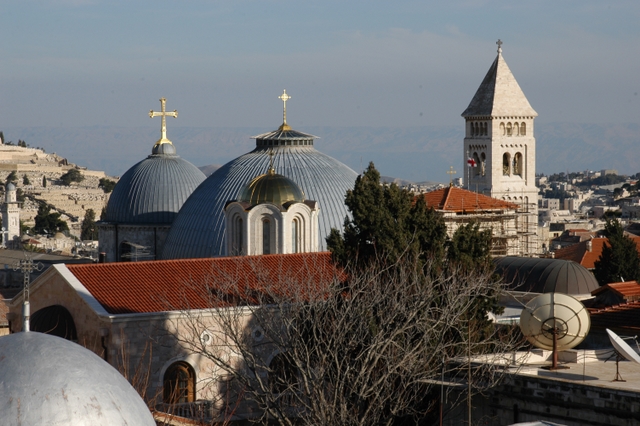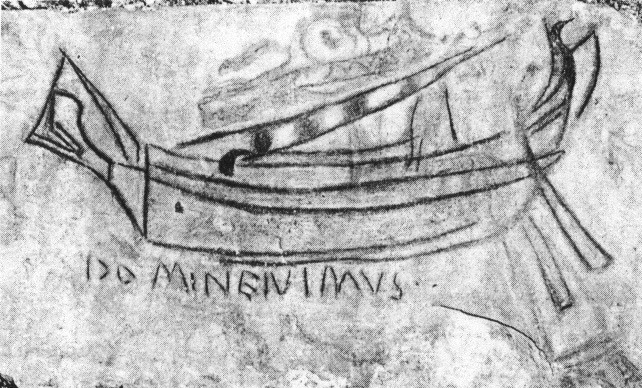Church of the Holy Sepulchre, 325 CE
Constantine’s mother Helena had met bishop Macarius of Jerusalem by chance at convocation of the first ecumenical council of the Christian Church convened by Constantine at Nicaea (in today’s Turkey) and was much moved by his words. The bishop told her of the sorry state of the faith in the land of its birth, and urged that the noblest act to further the new religion would be to mark, commemorate and preserve the sites hallowed by Jesus. A year later, with the blessings of her son, Helena journeyed to Jerusalem, and together with Macarius determined— arbitrarily, thought Robinson— the locations where Jesus had been crucified and buried. They decided that the two sites were close to each other, and over them Constantine built a great basilica, the Church of the Holy Sepulcher, which became the most sacred shrine in Christendom.
It was indeed an impressive edifice. No expense had been spared. In a letter to bishop Marcarius commissioning the building, Constantine had written-
It is fitting that your sagacity do so order and make provision for everything necessary, that not only shall this basilica be the finest in the world, but that the details also shall be such that all the fairest structures in every city may be surpassed by it…
From Jerusalem, queen Helena and bishop Macarius went to Bethlehem, and determined the site of the grotto where Jesus was born. Constantine’s erection of the Church of the Nativity followed.
These two magnificent shrines quickly drew pilgrims from afar.
Pearlman, Moshe, Digging up the Bible, New York- William Morrow and Co., 1980, p.33-34.
Jerusalem Ship Drawing. Discovered in the Church of the Holy Sepulchre in 1971.
On a large, smoothed stone which was incorporated in this wall, a pilgrim to the original church left a drawing of a merchant ship and the Latin inscription- “O Lord, we shall go.”
Israel MFA- Jerusalem- The Church of the Holy Sepulcher
In 348 CE, Just a few decades after the Roman Emperor Constantine declared Christianity a legal religion, a priest named Cyril, who later became bishop of Jerusalem, delivered a famous sermon in the newly constructed basilica of the Holy Sepulchre. In his address he said it would have been more appropriate to speak about the Holy Spirit in the very place where the Pentecost Spirit descended upon the apostles—namely “in the Upper Church of the Apostles.”
Baldi, Donato, Enchiridion Locorum Sanctorum (Jerusalem- Franciscan Printing Press, 1982; reprint of the 2nd edition of 1955), no. 730.
Cited in Meinhardt, Jack, ed. Crusaders in the Holy Land; The Archaeology of Faith. Washington DC- Biblical Archaeology Society, 2005, p. 70.
Church of the Holy Sepulchre 2
In 799 a delegation sponsored by the Patriarch of Jerusalem traveled to the capital of Charlemagne, Aix-la-Chapelle (Aachen), conveying greetings and gifts. In response, a delegation form Rome arrived in Jerusalem; when it returned to Rome on 23 December in the year 800, it brought along a number of local priests and presented Charlemagne with the keys to the Church of the Holy Sepulcher and the banner of Jerusalem. In this manner, Europe entered into a relationship of patronage vis-à-vis the Christian community of Jerusalem. Charlemagne initiated building projects in Jerusalem. These are described in detail by the Monk Bernard, who was in Jerusalem not long after the emperor’s death. In his account Bernard informs us-
“…city of Jerusalem, where we stayed in the hospice of the Most Glorious Emperor Charles. All who come to Jerusalem fro reasons of devotion and to speak the Roman language are given hospitality there. Beside it there is a church in honor of Saint Mary, and thanks to this Emperor it has a splendid library and twelve mansions, with fields, vineyards, and a garden in the Valley of Jehoshaphat. In front of this hospice is the forum, and any one who does his business there pays the person in charge an annual fee of two guineas.”
Prawer, Joshua and Haggai Ben-Shammai, eds., The History of Jerusalem; The Early Muslim Period 638-1099. Jerusalem- Yad Izhak Ben-Zvi, 1996
See also-
- Chronology of the Church of the Holy Sepulchre
- Byzantine Gold Ring
- Madaba Map, 527-565 CE
- Destruction of the Church of the Holy Sepulchre, 1009
- The Lintels of the Holy Sepulchre, 12th century
- Christian Jerusalem 324-638, Teddy Kollek and Moshe Pearlman, Jerusalem- Sacred City of Mankind, Steimatzky Ltd., Jerusalem, 1991.
- Royal Crusader Seal
- Chapel of Helena
- Entrance to the Church of the Holy Sepulchre 1
- Entrance to the Church of the Holy Sepulchre 2
- Entrance to the Church of the Holy Sepulchre 3
- Tower of the Church of the Holy Sepulchre
- Window in the South Face of the Church of the Holy Sepulchre
- Ruins near the Church of the Holy Sepulchre on the East Side
- Ruins near the Church of the Holy Sepulchre on the East
- The Church of the Holy Sepulchre, Palestine Exploration Fund, c. 1860.
- Crowd in Front of the Church of the Holy Sepulchre, 1898
- Shimon Gibson and Joan E. Taylor. Beneath the Church of the Holy Sepulchre Jerusalem. Committee of the Palestine Exploration Fund, London 1994.






